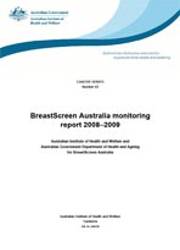Summary
BreastScreen Australia aims to reduce illness and death resulting from breast cancer in Australia. This is achieved through organised screening to detect cases of unsuspected breast cancer in women, enabling intervention at an early stage.
BreastScreen Australia operates as a joint program of the Australian and state and territory governments, targeting women aged 50–69 for 2-yearly screening mammograms (although women aged 40 and above are eligible to attend).
The following statistics refer to the latest data available for women in the target age group, 50–69.
How many women were diagnosed with, or died from, breast cancer?
In 2007, there were 6,297 new cases of breast cancer and 1,085 deaths. This is equivalent to 274 new cases and 47 deaths per 100,000 women.
In line with BreastScreen Australia’s aim to reduce death resulting from breast cancer, mortality has decreased since the program was introduced in 1991.
Despite breast cancer incidence being lower in Aboriginal and Torres Strait Islander women (171 new cases per 100,000 women compared with the non-Indigenous rate of 259) for 2003–2007, mortality from breast cancer did not differ between Aboriginal and Torres Strait Islander women and non-Indigenous women in the same period.
How many women participated in BreastScreen Australia?
More than 1.3 million women had a screening mammogram through BreastScreen Australia in 2008 and 2009. This was 55% of women in the target age group.
BreastScreen Australia provided equitable access to women across remoteness areas, with only 6 percentage points separating participation in Major cities and Very remote locations in 2008 and 2009.
The difference between Aboriginal and Torres Strait Islander and non-Indigenous women was greater — 37% of Aboriginal and Torres Strait Islander women had a screening mammogram in 2008 and 2009, compared with 55% of non-Indigenous women.
How many women were recalled for further investigation?
In 2009, 11% of women screened for the first time were recalled for further investigation, whereas for women attending subsequent screens, 4% were recalled.
How many women had a breast cancer detected?
In 2009, for every 10,000 women screened for the first time, 80 had an invasive breast cancer detected, whereas for every 10,000 women attending subsequent screens, 45 had an invasive breast cancer detected.
Small breast cancers (≤15mm in diameter) are associated with better treatment options and improved survival. A high proportion of breast cancers detected through BreastScreen Australia in 2009 were small — half (51%) of breast cancers detected in women at their first screen, and nearly two-thirds (65%) of those in women attending subsequent screens.



